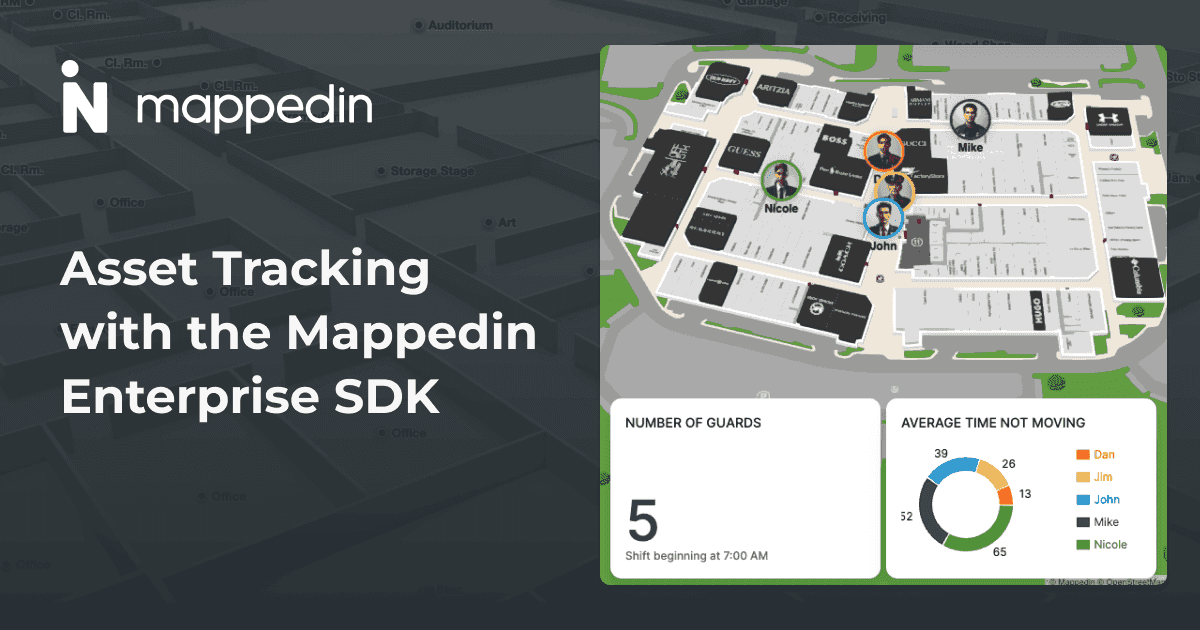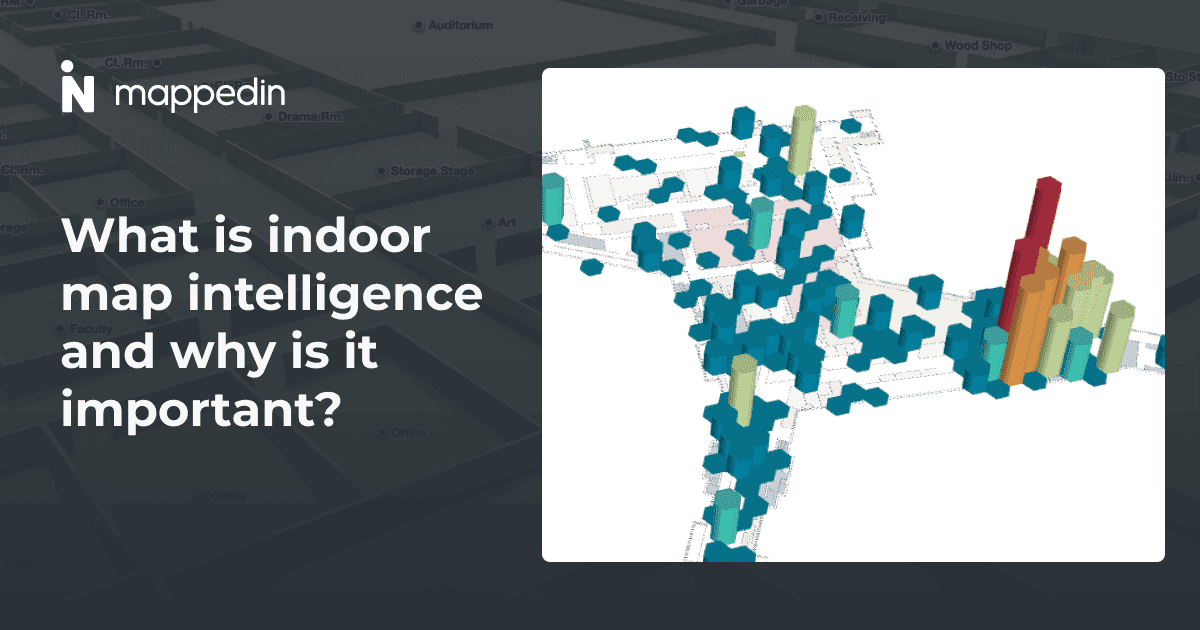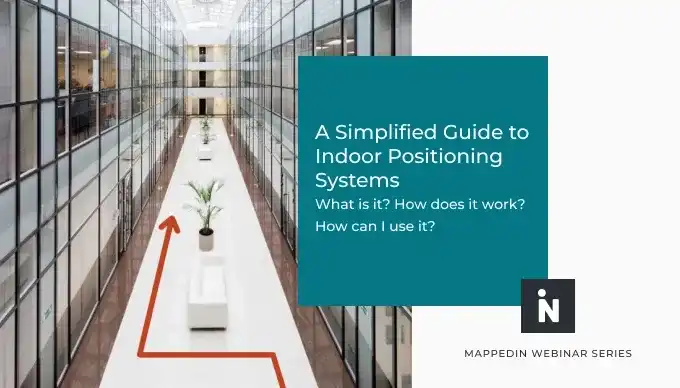Start Here
Location technology encompasses various positioning systems, including GPS for outdoor navigation, Wi-Fi, Bluetooth beacons, cellular networks, and RFID for indoor tracking, with indoor mapping serving as the crucial bridge where GPS fails inside buildings. Applications span across retail, healthcare, manufacturing, and logistics sectors, enabling enhanced customer experiences through personalized navigation, asset tracking, and location-aware services.
This beginner's guide will delve into the intricacies of location tech, shedding light on its key components, applications, and the role of indoor mapping experts such as Mappedin.
What is location technology?
Location technology is a broad term encompassing various tools and systems designed to pinpoint and track the geographical position of objects or people. In the realm of indoor mapping, companies such as Mappedin play a crucial role, providing simplified solutions for integrating indoor maps into existing location-based technologies.
Key components of location technology
- Global Positioning System (GPS): GPS is the backbone of outdoor location technology, relying on satellite signals to detect precise geographic coordinates.
- Wi-Fi Location Positioning: Wi-Fi-based positioning leverages wireless networks to determine the location of devices within an infrastructure.
- Cellular Location Positioning: Cellular technology enables location tracking through mobile networks, relying on cell tower triangulation.
- Bluetooth Location Positioning: Bluetooth technology allows for accurate indoor positioning by using low-energy beacons.
- RFID: Radio-frequency identification (RFID) involves tags and readers to identify and track objects wirelessly.
How location technology works
Understanding how location technology operates is fundamental to grasping its significance, especially for industries such as manufacturing, logistics, healthcare, and hospitality. This section will shed light on the inner workings of location technology, exploring key components that make it function seamlessly.
GPS mapping software and its functioning
GPS mapping software is the core of outdoor location technology. It translates signals from satellites orbiting the Earth into navigable maps, providing users with precise and real-time geographic coordinates. By combining signals from multiple satellites, GPS mapping software determines the exact position of a device, offering accurate outdoor navigation capabilities.
Role of mobile device location sensors
Mobile devices play a crucial role in enhancing location accuracy. Equipped with an array of sensors, these devices go beyond GPS signals. They use sensor data (from NFC, Bluetooth and Wi-Fi) to refine location information, providing a more nuanced understanding of the user's movement and orientation. These sensors contribute to a seamless navigation experience, with applications ranging from ensuring efficient patient care in hospitals to delivering seamless guest experiences in hotels and resorts, as well as facilitating efficient asset tracking for warehouses and logistics centers.
The importance of indoor maps in location technology
Understanding the crucial role of indoor maps is integral to grasping the full scope of location technology. This section will go into reasons why indoor mapping is essential, exploring how it complements location services and the key enabling technologies behind it.
How indoor maps complement GPS and other outdoor technologies
Indoor maps serve as the missing link in seamless navigation, complementing outdoor technologies such as GPS. While GPS excels in providing precise outdoor location data, it faces challenges inside buildings and structures.
Indoor maps step in to bridge this gap, offering detailed layouts of buildings, and making navigation efficient and precise within enclosed spaces. This is particularly vital for industries such as manufacturing, logistics, healthcare, and hospitality, where operations often occur indoors. Many maps can also incorporate indoor and outdoor data to provide seamless navigation between buildings such as at a corporate campus that has many office buildings.
Technologies enabling indoor mapping
BLE (Bluetooth Low Energy) Beacons
BLE beacons are small devices that transmit Bluetooth signals, facilitating accurate indoor positioning. Placed strategically throughout a facility, they create a network that mobile devices can tap into for precise location data. This technology is instrumental in providing real-time information for navigation and asset tracking within indoor environments.
RFID Systems
RFID systems use radio-frequency identification to track objects within a confined space. In the context of indoor mapping, RFID enhances accuracy by associating specific locations with tagged items. This provides value in sectors such as manufacturing and logistics, where efficient tracking of assets is paramount.
Wi-Fi-Based Indoor Positioning
Wi-Fi-Based Indoor Positioning uses existing Wi-Fi networks, creating an additional layer of accuracy within indoor spaces. By combining signals from Wi-Fi access points, this technology provides precise location information. Most industries such as manufacturing and logistics benefit from this innovation, ensuring efficient operations within enclosed areas. Wi-Fi-Based Indoor Positioning seamlessly integrates with other location services, enhancing overall navigation and enabling effective asset tracking.
Applications and uses of location technology
Leveraging existing Wi-Fi networks, Wi-Fi-based indoor positioning offers an additional layer of accuracy. By combining signals from Wi-Fi access points, this technology provides precise location information. Any industry can benefit from this technology, ensuring efficient operations within indoor spaces.
Everyday examples of location-based services
Location-based services are an integral part of our daily lives, seamlessly woven into various applications that enhance our experiences and make tasks more efficient. Let’s explore two primary examples: navigation apps and location-aware applications.
Navigation apps
Navigation apps have revolutionized the way we traverse the world. From the daily commute to road trips, these apps leverage location technology, including GPS, to provide real-time directions and traffic updates. Examples such as Waze, Google Maps, and Apple Maps guide users with turn-by-turn navigation, suggesting optimal routes based on current traffic conditions.
In warehouses and logistics centers, similar technology ensures efficient movement of assets and personnel, optimizing operations as a whole.
Location-aware applications
Beyond navigation, location-aware applications contribute to personalized experiences. Social media platforms such as Instagram and Meta use location data to enable check-ins, allowing users to share their whereabouts with friends.
In the healthcare sector, location-aware applications assist in patient tracking within hospitals, optimizing workflows and enhancing overall patient care. Hospitality industries also use location-aware apps for guest services, providing personalized recommendations based on their current location within a resort or hotel.
Indoor mapping in retail, healthcare, and other sectors
Retail
In the retail sector, indoor mapping transforms the customer shopping experience. Retailers can provide interactive maps within shopping malls or large stores, helping customers easily locate products and navigate the space. This not only improves customer satisfaction but also streamlines in-store operations, optimizing shelf stocking and inventory management.
Healthcare
Indoor mapping plays a crucial role in healthcare facilities, where precise navigation is essential for both patients and medical staff. Hospitals use indoor maps to guide patients to specific departments or rooms efficiently. Additionally, the technology assists healthcare professionals in locating medical equipment swiftly, leading to improved response times and overall operational efficiency.
Other Sectors
Beyond retail and healthcare, indoor mapping finds applications in various sectors. In large facilities such as airports, high-resolution indoor maps assist travelers in finding gates, services, and amenities. Similarly, educational institutions can use indoor mapping to guide students around campuses, ensuring they reach their destinations promptly. The flexibility of indoor mapping technology makes it a valuable asset in optimizing workflows across diverse industries.
Benefits of integrating location technology
Understanding the advantages of integrating location technology is essential for businesses seeking to enhance customer service and streamline operations. Let’s dive into the benefits and impact, both for customer satisfaction and company efficiency.
Enhancing customer experience with accurate location data
Accurate location data is a cornerstone in creating personalized and seamless customer experiences. Businesses can leverage this data to offer location-specific promotions, tailor marketing messages, and optimize service delivery. In retail, for example, accurate location data enables targeted advertising and improves in-store navigation, enhancing overall customer satisfaction.

Business advantages of using location-based services and indoor maps
Businesses can gain significant advantages by integrating user-friendly indoor maps into their existing location-based services. Here are several key benefits:
Enhanced Visualization: Indoor maps provide a visual representation of indoor spaces, allowing businesses to comprehend their environments more effectively. This enhanced visualization is particularly valuable for industries such as warehousing and healthcare, where precise navigation and asset tracking within complex indoor layouts are critical.
Optimized Asset Tracking: The combination of indoor maps and location-based services enables businesses to track assets with greater precision. This is especially beneficial for warehouses and logistics centers, where the ability to visualize the exact location of inventory, equipment, or personnel in real-time enhances operational efficiency and reduces the likelihood of errors.
Seamless Navigation: Indoor maps improve navigation within indoor spaces, offering employees, customers, or visitors clear and accurate directions. This is advantageous in various sectors, such as hospitality, where guests can easily navigate large resorts or hotels, and in healthcare, where patients and medical staff can move efficiently within hospitals.

Privacy and permissions in location technology
Managing location permissions on mobile devices
Managing location permissions on mobile devices is crucial for respecting user privacy. Businesses must implement transparent practices, seeking user consent before accessing location data. This ensures users have control over when and how their location information is utilized.
Balancing user privacy with location tracking Needs
Striking a balance between location tracking needs and user privacy is an ongoing challenge. Businesses can implement anonymization techniques and adopt strict data protection measures to safeguard user information. This not only builds trust with users but also ensures compliance with privacy regulations.
Future trends in location technology
Looking ahead, understanding the future trends in location technology is vital for businesses to stay ahead of the curve. Now, let’s take a look at upcoming research and advancements, with a specific focus on how indoor mapping technologies and the convergence of AI with location-based technologies will shape the landscape of various industries.
Advancements in indoor mapping technologies
The future of location technology holds exciting prospects, particularly in the realm of indoor mapping technologies. Advancements are expected to revolutionize how businesses visualize and navigate indoor spaces. Improved accuracy, real-time updates, and enhanced user interfaces will redefine the potential applications, providing businesses with powerful tools for optimizing workflows and delivering enhanced user experiences.
Convergence of AI and location-based technologies
An exciting trend ahead is the collaboration of artificial intelligence (AI) with location-based technologies. AI steps in as the analytical powerhouse, making sense of this location data through automated systems. By identifying patterns and trends, AI algorithms can make predictions and decisions. For instance, in a retail setting, AI analysis of foot traffic patterns can provide data-driven insights that help organizations optimize store layouts. It can also predict a customer's likely product preferences based on their location and past buying behavior. This dynamic partnership between AI and location-based tech opens up a realm of possibilities, enabling businesses to harness the full potential of their location data in smart and innovative ways.
Moreover, augmented reality (AR) is poised to enhance the convergence of artificial intelligence (AI) and location-based technologies, offering immersive and context-aware experiences.
Frequently asked questions
How do indoor maps differ from traditional GPS-based maps?
Indoor maps differ significantly from traditional GPS-based maps by providing detailed layouts of indoor places. While traditional GPS-enabled systems are effective outdoors, indoor maps excel in guiding users within structures, offering precise navigation in environments such as malls, hospitals, and warehouses. The focus on indoor spaces enhances the visualization and navigation experience for users.
What are the privacy implications of using location technology indoors?
The privacy and security implications of using location technology indoors revolve around the collection and use of sensitive data within confined spaces. As businesses integrate indoor maps with location-based services, it is crucial to prioritize transparent practices, secure data handling, and obtain user consent. This ensures that privacy concerns are effectively addressed.
How can businesses leverage indoor maps for enhanced customer experience?
By seamlessly integrating interactive navigation within indoor spaces, businesses not only optimize operational efficiency but also elevate customer interactions. These dynamic maps serve as a visual gateway, offering customers an immersive and engaging experience that goes beyond the ordinary, resulting in heightened satisfaction and loyalty.
Schedule a meeting with our team, one of Mappedin’s experts specializing in location intelligence, to explore how our cutting-edge indoor mapping technology can elevate your location-based projects. Your journey into customizable and scalable indoor location solutions begins here.
Tagged In
Share


